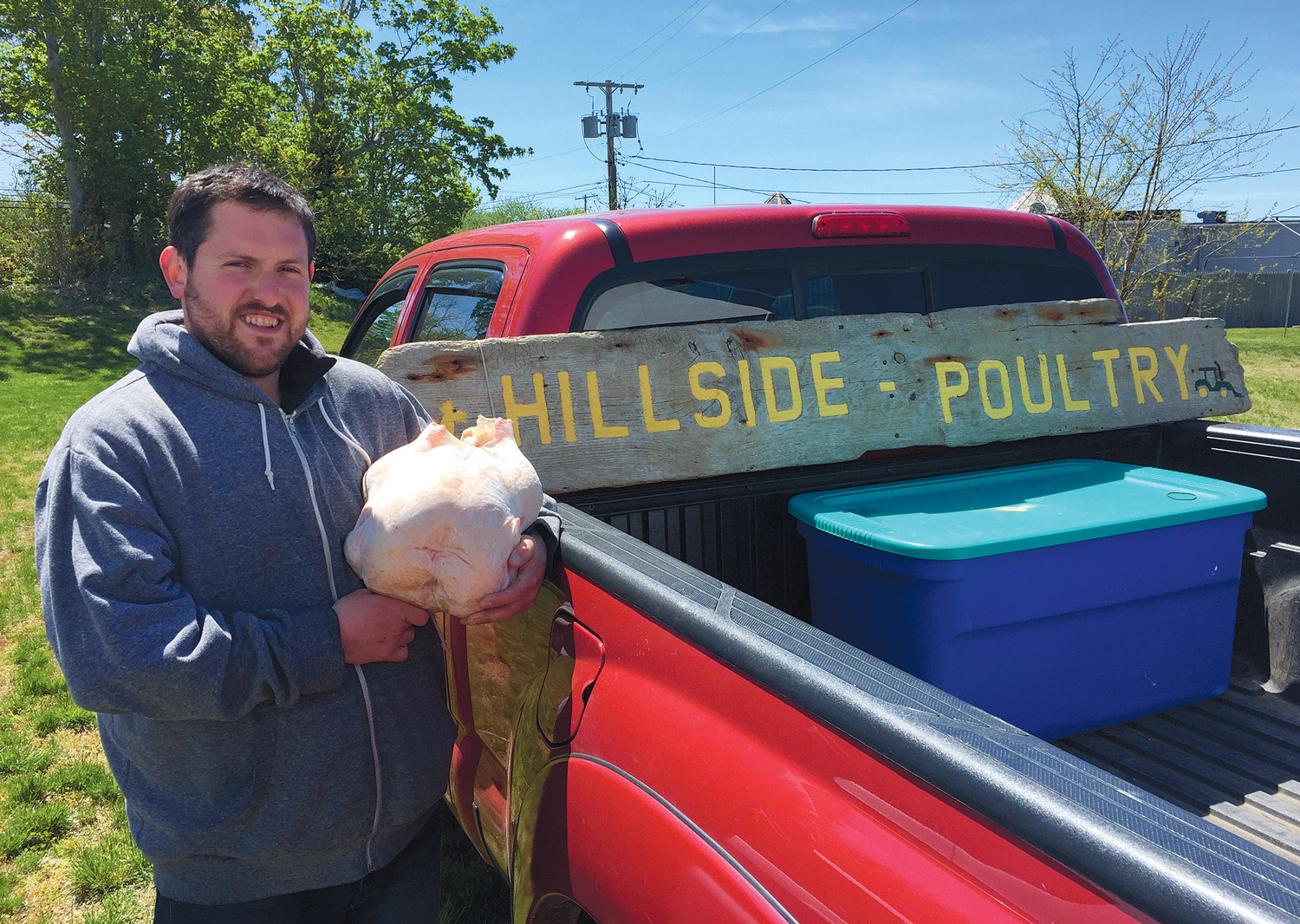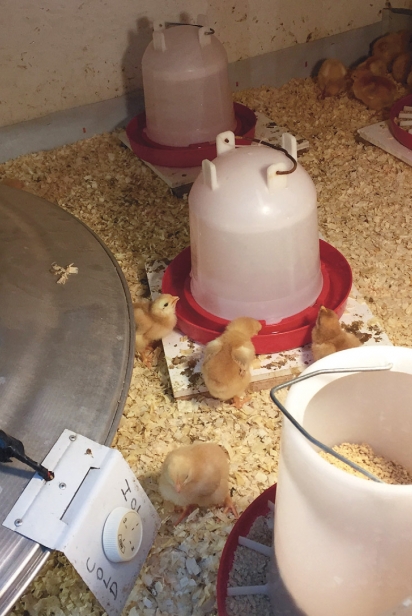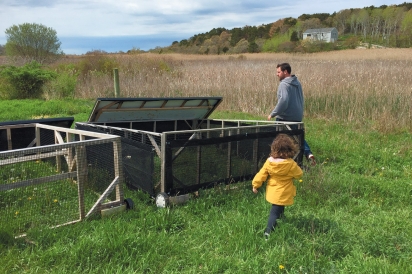Turkeys and Ducklings and Goats, Oh My!
Growing Hillside Poultry
Steve Locke told his grandson that whatever he considered doing, just let it not be farming. A 1959 graduate of the University of Massachusetts Stockbridge School of Agriculture, he knew first-hand the sacrifices made while trying to farm on Cape Cod.
Drew Locke, that grandson, thankfully didn’t mind a word of the elder Locke’s advice. Instead, he shares the very same alma mater, capping off his studies with a Masters in Sustainable Food and Farming. Born of a life begun on land used agriculturally for over a century, Locke’s expansive vision for local food systems involves family, friends and community.
Beginning nearly a decade ago, as a sideline to his full-time job, Locke added seventh-generation farmer to his resume. His early years as a novice chicken wrangler were detailed by Mary Petiet in the summer 2013 issue of Edible Cape Cod. Petiet profiled Locke’s passion for raising his birds using a method popularized by Joel Salatin of Polyface Farm: moving the chickens daily, in portable pens, to graze fresh pasture. “The farm-to-table movement was just beginning then, and once I had done the work, it gave me a real opportunity to succeed,” says Locke.
Locke dove in to learn his craft, using a site leased from other family members near enough to the bay to smell the sea. Close by is the small antique home Locke shares with his two girls: high school love and now wife, Amie, a teacher at the Latham School in Brewster, and three-year-old daughter Remi, who scamps around the grounds in her farm boots. At his wooden dining table, ticking off the many challenges of a Cape Cod location, Locke says, “There’s weather, the wind and the rain and the temperature to consider, not to mention predators.”
Tweaking the design of his moveable chicken accommodations each time he has a revelation makes this year’s model number four. He points to each feature’s advantages while sketching its design on paper. One thing he’s added is a lobster trap wire enclosure over the gutters that serve as feeding troughs. “Wild birds, for example, they’ve been a real problem,” says Locke. “It’s just the average ones that eat all the chicken feed though, like the robins and barn swallows.”
Locke added perching spots too. Now his chickens can avoid sleeping on the often cold ground and potentially flattening their breasts. It’s not just adapting their lodgings, but the chickens themselves that Locke has tweaked. Starting initially with Freedom Rangers, he now favors the Robust White, which is a cross between a Freedom Ranger and a Cornish Rock. “Still a pasture forager, but with a bigger breast,” says Locke.
By the numbers, Locke averages 100 meat chickens per week in the high season, which runs from late June to Thanksgiving. That translates to intense periods of labor as he works diligently to keep the chicks healthy from their arrival (via regular mail in a cardboard box), until they can fend for themselves in the great outdoors. This part of the process takes place in a hoop house of Locke’s own design, built with family and friends. More cavernous than most, this structure houses not only the chick nurseries, but also the well for the water supply and the electrical system that powers the four brooders in the building.
Locke credits friend and former flock inspector Alex MacDonald, now retired, with helping him to master the chick parenting ropes. “MacDonald provided the greatest amount of help in guiding me in how to take them from new hatchlings to young birds that can navigate outdoors,” says Locke. “They arrive to us at most two days old, sometimes still bearing a fleck of shell on their bodies. Chicks can survive without anything at the outset because they get nutrition from their internal yolk sac.”
Brooders, the ones in the greenhouse, are devices named after the broody hens that sit on fertile eggs waiting for them to hatch. Because the chicks arrive as orphans, Locke needs to mimic the experiences they would have encountered in nature until they are mature enough to be moved out to pasture.
Each brooder is a large metal dome suspended over the straw covered floor just low enough so that the chicks clear it without hitting their heads as they bobble about underneath. Wired to the dome are several porcelain lights whose only purpose is to provide the warmth the chicks would feel if under their moms. Locke says, “There are no red or any other colored lights present to confuse the chicks. We only want to strengthen their response to temperature.”
At the height of the season all four of Locke’s brooders are operational with each one placed in a unique rectangular area abutting the exterior wall extending the length of the hoop house. Each successive day he moves the water and feed containers farther from the chicks in an effort to inspire them to leave the comfort of the brooder dome to forage for food and then return to the warm area. After five days the lights are turned off completely.
“I’ve learned to watch their transitions very carefully, supplementing their water the first few days with some electrolytes only when necessary. It’s important that they thrive, but they have to work for it too. You really want the chicks to immediately learn to return to the area of heat under the dome that represents their mother’s warmth,” says Locke.
After a week, one wall is removed from the separate areas, extending each pen to about twice its original size and lengthening the distance the chicks will need to travel for food and drink. This happens again seven days later when the pen is enlarged for the final time. “It’s a cyclical system,” says Locke. “I consistently rotate the batches. Every chick being fully covered with feathers is my measuring stick that a group is ready to make the leap to pasture grazing.”
Before even stepping into the pasture, each bird has experienced hours of Locke’s caregiving. Once placed in their custom made pens, the birds move to different 10' x 12' areas of Locke’s pastureland every day. Near the end of their lives when their grazing intensifies, it’s twice a day. Each pen comfortably houses 60 birds and half that number can access the dry food at any one time. Much of the area is covered from the elements and the grain and water bar is open 24/7.
Ferrying pens full of adolescent chickens across pastureland has been a design issue as well. Initially pulling his pens to their targets because it was easier, Locke switched to pushing them, outfitting each with sets of tricycle wheels. “I have to move the pens with the birds in them, so although it’s harder on me this way, I can keep a better eye on my chickens and scurry them along from behind,” says Locke.
Open uncontrolled free-range feeding, Locke explains, can burn out pastureland. The birds selectively feed on their favorites first, nearly running those species into extinction. Likening their diet to ours, he says, “It’s like us eating all the ice cream first, and leaving the liver and onions.”
Locke’s directed method differs by focusing the chickens to forage intensely each day from grassland that’s in prime shape nutritionally. “Their pens are floor-less so they have their choice every day of eight to ten different species of grass,” says Locke. “My birds are pumped and ready to go each morning when I move them onto the next plot of new growth greens.”
Locke admits that overwhelmingly, poultry hatcheries worldwide don’t agree with his pasture grazing routines. “There are just too many elements to control to have a flock do well, like heat, sun, wind, water temperature, shade, ground temperature, and moisture,” he says. “I know how much easier it is to control it all indoors because I’ve done it. You feed them hay, it’s easy and quick.”
For Locke, trying the easier option didn’t budge his view one bit. Pasture grazing is labor intensive, has many variables that can raise havoc, and doesn’t bring in tremendous income, yet, “I really believe these birds should be grazing on pasture and that we should mimic their genetic makeup for them to thrive,” says Locke.
One upside for Locke is that grazing his flock is a very effective manure management system. Once the chicks are outdoors, nature recycles their waste. Yet even just a stray morsel of chicken poop soon becomes an issue once turkeys come into the mix, adding just one more demand to Locke’s routine. “It’s problematic because turkey species have become so domesticated. I need to carefully isolate them from the chicken waste because it can cause them to contact disease.”
Two or three years ago, when customers and friends hankered for Thanksgiving turkeys, Locke invested in a new structure to house a turkey flock now averaging about 60 birds a year. “They’re not roamers like chickens; they stay pretty much in one place. I built them two enclosed raised porch areas where they can rest off the ground, protected from summer’s heat,” he says.
Compared to chickens, which come to market in about eight weeks, turkeys take just shy of three times that long, or 23 weeks. So the investment is much greater in a bird that’s going to be nurtured that long. Plus turkeys require a greater protein content game bird feed than the chicks for a full 12 weeks, adding to their cost, although at the finish line the turkey’s per bird price is much higher.
Ducks, which Locke raises only upon request for a trio of local chefs—Michael Ceraldi of Ceraldi in Wellfleet, Eric Jansen of Black Fish in Truro, and Guy Yingling of Bubala’s in Provincetown—are a complete labor of love. “They’re pure headache time for me, beginning with the passing of their liquid-y manure, which they seem incapable of controlling, to their final processing. Because ducklings possess a layer of down, in addition to their feathers, they’re extremely difficult to pluck, much more so than chickens.” Locke says. “I do it for these guys because these individuals are extremely supportive of me. I can raise product and they will buy it, no matter what.”
Keeping all the varied birds on the farm safe from predation is an ongoing dance that Locke perpetually fine-tunes. “There’s been hawks, coyotes, weasels, fox and many others in the mix. We have to deter rats from ambushing the hoop house to eat our stored feed, and owls have attacked in the pastures and exited without even eating a bite of the prey they’ve killed.”
A recent job change closer to home may allow Locke the flexibility to own a guard dog for the farm. “I’ve just accepted the position of Head Custodian at the Truro Central School, a mile or two from my farm,” says Locke. “I couldn’t be more happy to be in this community and will work as hard as I can to keep the facility clean and safe and for it to have nutritious food. I want this environment to be one where kids can learn and be happy and be heard when they have something to say. They’re our future.”
Looking to that future, Locke churns out more options, including introducing bees, fruit trees, grapes and berries. In a few weeks one particular venture at Hillside Poultry may require a name tweak; baby goats will be joining the ark. “I believe in eating the smaller more nutrient dense species, like mackerel in place of tuna,” says Locke, “and so I’m trying some goats.”
“Cows are too heavy to pasture here because our water table is at ground level. I don’t have much upland pasture to graze, but goats are so light that I thought that they might be a good choice,” says Locke. “There’s the possibility of meat, cheese and milk, but I’ll worry about that later, for now I’m intent on learning how to raise them.”
“My senior capstone project at UMass Amherst focused on strengthening our food base by an integrated farm plan woven of animals, vegetables, community and schools,” says Locke with a smile. “It’s all coming together now.”
Early in May 2019, at the invitation of his friend Michael Ceraldi, Locke attended Chef Ceraldi’s Taste of the Cape evening at the James Beard House in NYC. The James Beard Foundation’s mission is to “celebrate, nurture and honor chefs and other leaders making America’s food culture more delicious, diverse and sustainable for everyone.” With this event a sell-out, Ceraldi was honored with a second evening (one of only four chefs in the program’s history to do so). The spotlight was on regional foods grown, harvested or created on land or sea by Cape Cod’s farmers, artisan chocolatiers, coffee roasters and the like. “Ceraldi created an experience that was bomb,” says Locke.
Three of the seven courses featured Locke’s farm-raised meats. Ceraldi, who tapped into the energy of the evening by hopping onto the bar at the night’s end, says, “The ravioli stuffed with his chicken liver was the most acclaimed dish of the evening.”
Back home in Truro, as Locke surveys his farmstead, it’s clear he’s found his somewhere over the rainbow. Beaming, he shares his daughter Remi’s most recent comment, “When I’m a big girl, they’ll be my chickens.”
Hillside Farms
300 Route 6, Truro
(Memorial Day-Columbus Day)
To order, email hillsidepoultry@gmail.com or phone 508-241-2587
Also available at Orleans Farmers’ Market on Saturdays 8-noon







